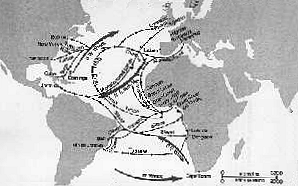Bristol
and
Slavery

The Middle Passage
The voyage that carried Africans into slavery across the Atlantic Ocean was called the "Middle Passage".
Having arrived at the African coast, captains were anxious to make their stay as short as possible to avoid disease and mutiny. Slaves were taken from the holding forts, shackled together in pairs with leg-irons and carried to the ships in dugout canoes. Once aboard their clothes were removes and they were branded with a red-hot iron like cattle, to show who owned them.
Slaves were housed in the ship's hold like any other cargo. The men were kept in chains whilst women and children were allowed to go free. Slaves lay on specially built shelves with about 0.5 metres of vertical space, the men still fettered in pairs. As long as they were in the hold, slaves had to remain lying flat on their backs. Once the available spaces were filled the captains would set sail.
During the transatlantic crossing, the slaves were brought up out of their steamy dungeon each morning.
The men's' leg-irons were linked to a chain running down the centre of the ship's deck to prevent them jumping overboard.
On some ships they were made to dance for exercise.
Slaves meals were normally a kind of porridge made from maize or millet. A second meal might be provided in the afternoon, usually the same as the first. Whilst on deck, a good captain had the slaves washed down with warm vinegar and scrubbed. Some did not bother and in rough weather the slaves would not be allowed out at all.
Shackled in darkness and filth, seasickness and disease were rife. The heat in the hold could be over 30°C and the slaves would have no access to toilets or washing facilities. So foul was the smell of slave ships that other vessels took care to steer well away from them, in fear of contracting a disease.
In such conditions disease spread, and many slaves died. It was not rare for hundreds to die in an epidemic; occasionally every African on board was dead by the time the ship entered Caribbean waters. Their bodies would be thrown overboard.
Slaves were valuable cargo, so a good captain would do his best to keep as many alive as possible. However, many slave captains were notorious for their cruelty. The actual voyage could take from 6 weeks to three months.
It has been estimated that between 9-11 million people were taken from Africa by European traders and landed alive on the other side of the Atlantic. But as the average loss was 1/8 of all slaves, it can be estimated that a further 1½ million Africans are buried in the Atlantic Ocean between Africa and the Americas.
At the end of the voyage came the "sale" of the cargo. Africans were inspected for physical faults and auctioned like cattle. Families were split up forever and life as a plantation slave would begin.
Meanwhile, the captains totted up the profits and the crew began cleaning out the ship to take on a cargo of colonial produce, which had to be carried in better conditions than the slaves had endured. As soon as the ship was ready and loaded, the final part of the Trade Triangle, The Return Passage, could begin.
Links
» John Barbot Jnr, a European slave trader, gives his account of a slave revolt in 1770
» Olaudah Equiano, a child slave, describes his 1789 journey on the Middle Passage
» Alexander Falconbridge, ship's surgeon, describes life on the Middle Passage (1788)




